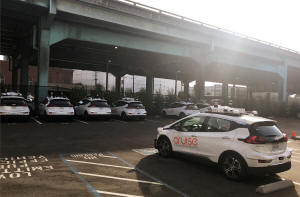US probes GM's Cruise robocars over pedestrian close calls
 Send a link to a friend
Send a link to a friend
 [October 28, 2023] By
Greg Bensinger [October 28, 2023] By
Greg Bensinger
SAN FRANCISCO (Reuters) -General Motors’ autonomous vehicle unit,
Cruise, is facing multiple federal investigations over its cars’ safety,
including two incidents where the robot cars appeared not to yield to
pedestrians in crosswalks, according to a U.S. regulator's letter
released on Friday.
Cruise autonomous cars "may not be exercising appropriate caution around
pedestrians in the roadway," according to the letter dated Oct. 20 from
the National Highway Traffic Safety Administration. "This vehicle
behavior could increase the risk of a collision with a pedestrian which
in turn may result in injury or death."
NHTSA previously made public another Oct. 20 letter in which it raised
concerns over several hard-braking incidents by Cruise vehicles that
resulted in collisions.
Safety officials cited two videos where Cruise vehicles came close to
pedestrians in crosswalks and appeared to nearly strike them. In one,
the vehicle is observed steering toward a pedestrian walking a dog,
before braking, causing the pedestrian to pause and pull back on the
leash. In the other, the car appears to narrowly avoid striking four
pedestrians in a crosswalk, including two small children, before it
continues down the street.

Asked about the videos, Cruise said on Friday the vehicles were tracking
all pedestrians in both cases and that it has "made improvements as part
of our process of continuously enhancing our technology to give
pedestrians more space around our vehicles."
The company said of NHTSA's inquiries that it "cooperated with each of
their requests to date as part of the ongoing investigation process and
will continue doing so."
NHTSA said it was seeking additional information from Cruise about the
pedestrian incidents including all videos running from at least 30
seconds before and after each event and composite renderings. The agency
is seeking the information by the end of Oct. 27.
[to top of second column] |

A Cruise self-driving car, which is owned by General Motors Corp, is
seen outside the company’s headquarters in San Francisco where it
does most of its testing, in California, U.S., September 26, 2018.
REUTERS/Heather Somerville/File Photo

The NHTSA probes add to Cruise’s October woes after the California
Department of Motor Vehicles ordered the driverless cars to be
removed from state roads, calling them a public hazard and alleging
the company had "misrepresented" the safety of the technology.
Cruise had been operating an Uber-like service with unmanned
vehicles, primarily in San Francisco, but the company halted that
service this week. It is still allowed in the state to test
autonomous cars with human safety drivers.
Cruise is competing with Alphabet’s Waymo unit, and others, to
develop the robot cars for wider production and deployment.
Perfecting the technology will take years of real- world testing,
but the companies have run in to resistance from some lawmakers and
citizens who said they fear the vehicles are as yet unproven and
pose a safety risk.
Cruise and Waymo have deployed the cars in several states in
addition to California, including Arizona and Texas. As of Friday,
Waymo vehicles continued driverless passenger operations in San
Francisco, its main hub.
The Teamsters union, which has publicly opposed the broad rollout of
autonomous vehicles, said Cruise's decision to pause driverless
operations nationwide "is a major concession by the industry."
"It’s a cautionary tale of what happens when we let AV companies
govern themselves."
(Reporting by Greg Bensinger in San FranciscoAdditional reporting by
David Shepardson in WashingtonEditing by Matthew Lewis)
[© 2023 Thomson Reuters. All rights
reserved.]
This material may not be published,
broadcast, rewritten or redistributed.
Thompson Reuters is solely responsible for this content.
 |